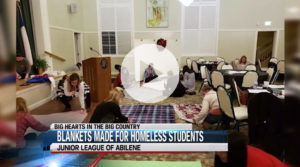Homeless Youth
About
In 2018, Junior League members were educated on the homeless youth population in Abilene, learning that by the spring of 2018 there were more than 1,400 youth that identified as homeless or unaccompanied in the AISD school system. After education and training, the Junior League formed the Homeless Youth Program within the League.
The Homeless Youth Project is a collaboration between the Junior League of Abilene and Abilene ISD’s Department of Homeless Services, including other multiple agencies within the community that serve the homeless youth population in Taylor County. The League works with these partners to identify resources needed addressing the issue(s) of (1) health and hygiene, (2) clothing & other necessary resources, and (3) food insecurity.
Over 1600 Tide laundry pods distributed to 16 AISD campuses; 100+ hygiene kits provided; over 200 undergarments provided to the Homeless Youth Closet, and over 44 volunteer hours were provided by Junior League members this year.
Our Goal
Our priorities are to setup and assist in building a student closet and student laundry/hygiene room. Members additionally help the AISD Homeless Liaison organize, manage, and help pass out items in the existing resources closet as well as making resources needed known to ensure that items are always accessible at the time most needed.
Defining Homelessness
The Junior League of Abilene accepts the same definition contained in federal law (McKinney-Vento Education for Homeless Children and Youth Act) which defines “homeless children” to be those who lack a fixed, regular, and adequate nighttime residence.
More specifically, the following also meet the definition of “homelessness”:
- In a shelter (family shelter, domestic violence shelter, youth shelter, or transitional living program);
- In a motel, hotel, or in weekly-rate housing;
- In a house or apartment with more than one family because of economic hardship or loss;
- In temporary foster care or with an adult who is not the student’s parent or legal guardian;
- In sub-standard housing (no electricity, no water, and/or no heat); or
- With friends or family because the student is a runaway or an unaccompanied youth.